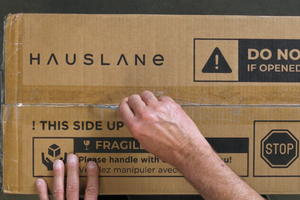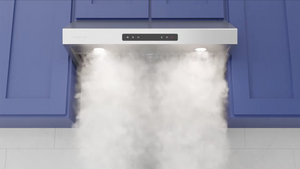What To Do if Your Kitchen Doesn't Have a Vent
Here’s the thing about cooking smells. When you’re getting ready for a meal, they’re wonderful but once you’re finished eating, lingering odors can be far from appetizing. If you don't have a range hood, opening a door or plugging in a fan is most likely your go-to option. You’ll be excited to learn there are more odor-ridding solutions for kitchens without vents that can help keep your house smelling fresh and looking cleaner.
What We'll Cover


1. Use an Air Filter
An air filter can significantly improve the quality of the air you breathe. During cooking, various pollutants and odors, such as smoke, grease particles, volatile organic compounds (VOCs), and food odors, can be released. By using an air filter, these contaminants are removed, resulting in a fresher and healthier indoor environment.
Secondly, an air filter in the kitchen helps reduce unpleasant odors and smoke. Cooking smells can linger and spread throughout the house. Air filters with an activated carbon filter can trap and eliminate cooking smells. They are also useful for reducing false alarms from smoke detectors and maintaining a cleaner kitchen environment.
2. Use a Window Fan
A window fan has similar advantages to an air filter. Using a window fan in the kitchen can bring some great advantages. Firstly, it helps with ventilation by creating a flow of fresh air. When you're cooking, steam, smoke, and lingering odors can fill the air. But a window fan comes to the rescue by pulling out all that stuff and bringing in fresh air from outside. It keeps your kitchen well-ventilated, making it more comfortable to work in.
Secondly, a window fan is excellent for removing smoke and excess heat. Some cooking methods can generate a lot of smoke or make your kitchen feel hot and stuffy. With a window fan in place, it efficiently draws out the smoke and expels hot air, allowing cooler air to come in. This not only keeps your kitchen fresher but also helps in cooling down the space, making your cooking experience more enjoyable. Plus, it can save energy by reducing the need for excessive air conditioning.
3. Get a Grease Spatter Guard
Grease spatter guards provide reliable shields against messy and potentially hazardous grease splatters, keeping your stovetop, countertops, and walls clean and grease-free. This not only saves you from the hassle of cleaning but also reduces the risk of accidental burns or fires caused by hot grease.
Additionally, a grease spatter guard helps minimize unpleasant cooking odors by containing the volatile particles that can contribute to lingering smells in your kitchen. By trapping the grease and preventing it from dispersing into the air, it helps maintain a fresher and more pleasant cooking environment.
4. Wipe Down Your Kitchen Cabinets Regularly
Make sure to wipe down your kitchen cabinets on a regular basis. Food particles and grease can build up on your cabinets over time and are difficult to remove once they’ve sat on the cabinets for a while. This is not only unsightly but can also leave odors in the kitchen. Wiping them regularly will improve your cabinets' longevity and reduce the risk of bacteria growth.
5. Consider Getting a CO2 Meter
Consider getting a CO2 meter in the kitchen for added safety and peace of mind. Carbon dioxide (CO2) is produced during cooking processes that involve the use of gas stoves, ovens, or grills. While CO2 is generally harmless in small amounts, high concentrations can be dangerous and potentially life-threatening. By installing a CO2 meter in the kitchen, you can monitor the levels of carbon dioxide and take necessary actions to prevent any adverse effects.
Having a CO2 meter provides early detection of potential gas leaks or improper ventilation, which can lead to an increase in CO2 levels. This is particularly important if your kitchen is not adequately ventilated or lacks windows for natural air circulation. A CO2 meter acts as a warning system, alerting you when CO2 levels rise beyond safe limits.
6. Wash Fan Filters Regularly
Fan filters trap dust, dirt, pet dander, and other airborne particles circulating in your home. Over time, these particles accumulate on the filter, obstructing airflow and diminishing the filter's effectiveness. By washing the filters regularly, you remove these accumulated pollutants, allowing the fan to operate efficiently and ensuring cleaner air circulation.
When filters become clogged with debris, the fan motor has to work harder to maintain proper airflow. This increased strain can lead to reduced performance, increased energy consumption, and even premature wear and tear on the fan. Cleaning the filters is important to maintaining optimal airflow, which allows the fan to operate smoothly, efficiently, and prolongs its lifespan.
7. Install a Kitchen Vent
You may also consider having a vent installed. Vents play a crucial role in smoke and grease removal. When you're cooking, especially with high-heat methods, smoke can fill the kitchen, triggering smoke alarms and leaving behind unwanted odors. With a vent, the smoke is swiftly whisked away, which helps to create a safer, clean environment.
8. Get a Ductless Range Hood
Regardless of whether you have a vent or not, you definitely need a range hood in your kitchen. Fortunately, there are plenty of options to choose from. Range hoods vary across price points, designs, performance levels, and sizes. You can also find them in vented or unvented models or ducted vs. ductless. Vented range hoods have a fan and are attached to a duct in the kitchen so the air can be vented to the exterior of the house. By comparison, unvented hoods have a fan but do not use a duct.
You might be wondering how an unvented range hood works if it doesn’t use ductwork. This type of range hood uses charcoal filters to clean the air before it is recirculated. The filters are used to trap grease and neutralize odors.
High Quality Ductless Hoods
From Hauslane

Comparing Vented Range Hoods to Unvented Range Hoods
Range hoods vary across price points, designs, performance levels, and sizes. You can also find them in vented or unvented models or ducted vs. ductless. Vented range hoods have a fan and are attached to a duct in the kitchen so the air can be vented to the exterior of the house. By comparison, unvented hoods have a fan but do not use a duct.
You might be wondering how an unvented range hood works if it doesn’t use ductwork. This type of range hood uses charcoal filters to clean the air before it is recirculated. The filters are used to trap grease and neutralize odors.

The Advantages of Ductless Range hoods
So, why would you choose a ductless range hood? Here are some of the main benefits that this type of range hood offers:
✦ Versatility of Installation
It’s not always easy or even possible to add duct and install a range hood. For a ducted under cabinet range hood, you would need ductwork through or behind the cabinets. With an island range hood, you’ll want to run ductwork up the ceiling. In some smaller kitchens such as those found in condos and apartments, there may not be space to run ductwork.
With a ductless range hood, you can mount it anywhere you choose. No ductwork or major renovation required. This makes for an easier, more practical installation. You can even add a vent cover for some custom style. (Learn how to install a vent hood cover here).
✦ Fewer Costs
The costs of adding ductwork and the related renovations can add up fast. Ductless range hoods are also less expensive in general. Hauslane’s ductless range hoods can be easily set up and plugged in without professional assistance.
✦ Efficient Filters
Charcoal and aluminum filters are the “secret sauce,” so to speak, of ductless range hoods. These filters are replaceable and should be changed every few weeks (or as soon as you notice a difference in performance quality). At Hauslane, we offer a convenient charcoal filter subscription, so you’ll always have a new pair ready when you need them. Ductless range hoods also use aluminum mesh filters for extra-grease trapping.
One thing to note about ductless range hoods is that they won’t offer quite the same level of heavy-duty performance as a ducted range hood. If you cook often and use high temperatures, you may find a ducted model to be more effective. However, if you can’t add ductwork or need versatility in your installation, ductless range hoods are a good choice to improve your indoor air quality.
Browse Kitchen Range Hoods
From Hauslane
With Hauslane, you can convert our range hoods to ductless with just a pair of charcoal filters. Then, you’ll be well on your way to enjoying a brand new cooking experience! Stay tuned to the Hauslane blog for even more tips and tricks.








